Wolverhampton Wanderers had a difficult start to the 2022-23 campaign, earning just 11 points from their opening 16 games. That run of form had Wolves stranded in the Premier League relegation zone leading to the dismissal of manager Bruno Lage.
Spaniard Julen Lopetegui replaced the Portuguese. Lopetegui, appointed in November, used the World Cup break to improve his new team. Results quickly improved after the break, with Wolves winning on four of their next seven outings.
Although there were a few setbacks along the way, including a 6-0 thrashing at the hands of Brighton, Wolves ended the season comfortably clear of relegation. Whilst avoiding the drop was almost certainly Lopetegui’s remit, overall, Wolves will be disappointed with the season. Finishing in 13th position on 41 points, this was their worst points tally since returning to the Premier League in 2018.
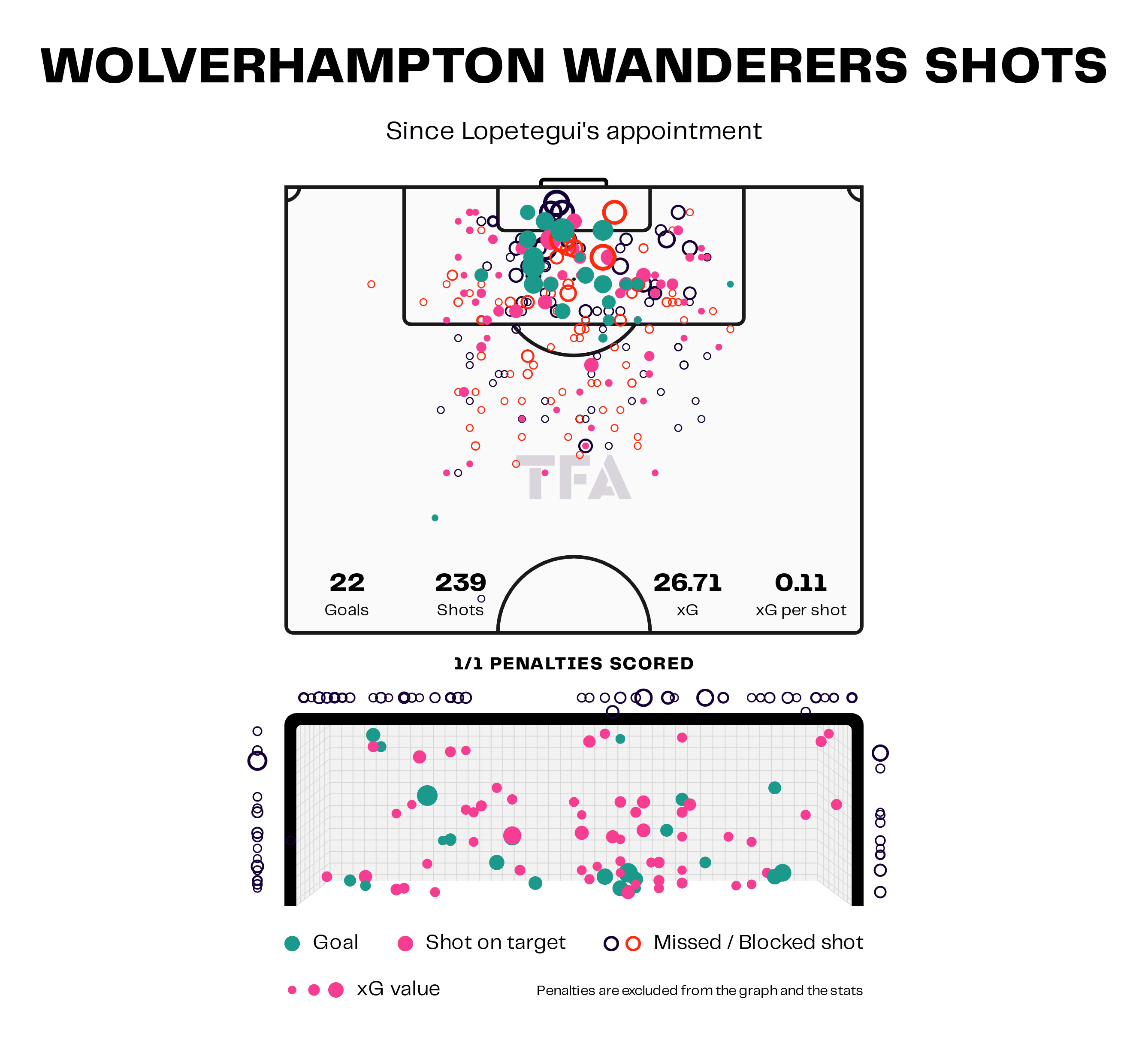
With a mere 31 goals scored in the league, finding the net was clearly a fundamental problem for Wolves last term. Their final tally was the lowest in the league and a whopping 23 goals below the league average. It was also 20 goals less than relegated Leicester City managed to amass.
In simplified terms, Wolves needed to take more shots at goal. With an average of just 9.12 per game, they had the fourth-lowest shooting average in the league. The quality was poor when they did have shots, with only 31.8% being on the frame, the worst on-target shot percentage in the Premier League.
They are, however, on an upward trajectory. In 8 of the 16 games before his arrival, Wolves scored just eight of the 31 goals they would go on to bag. They also failed to score at all in 9 of those 16 matches. Wolves only failed to net on a further six occasions throughout the rest of the season. Lopetegui managed to turn their shooting woes around to some extent. His side finished the campaign with a total xG of 38.7. This ranked them 13th in the division, aligned with their final league position.
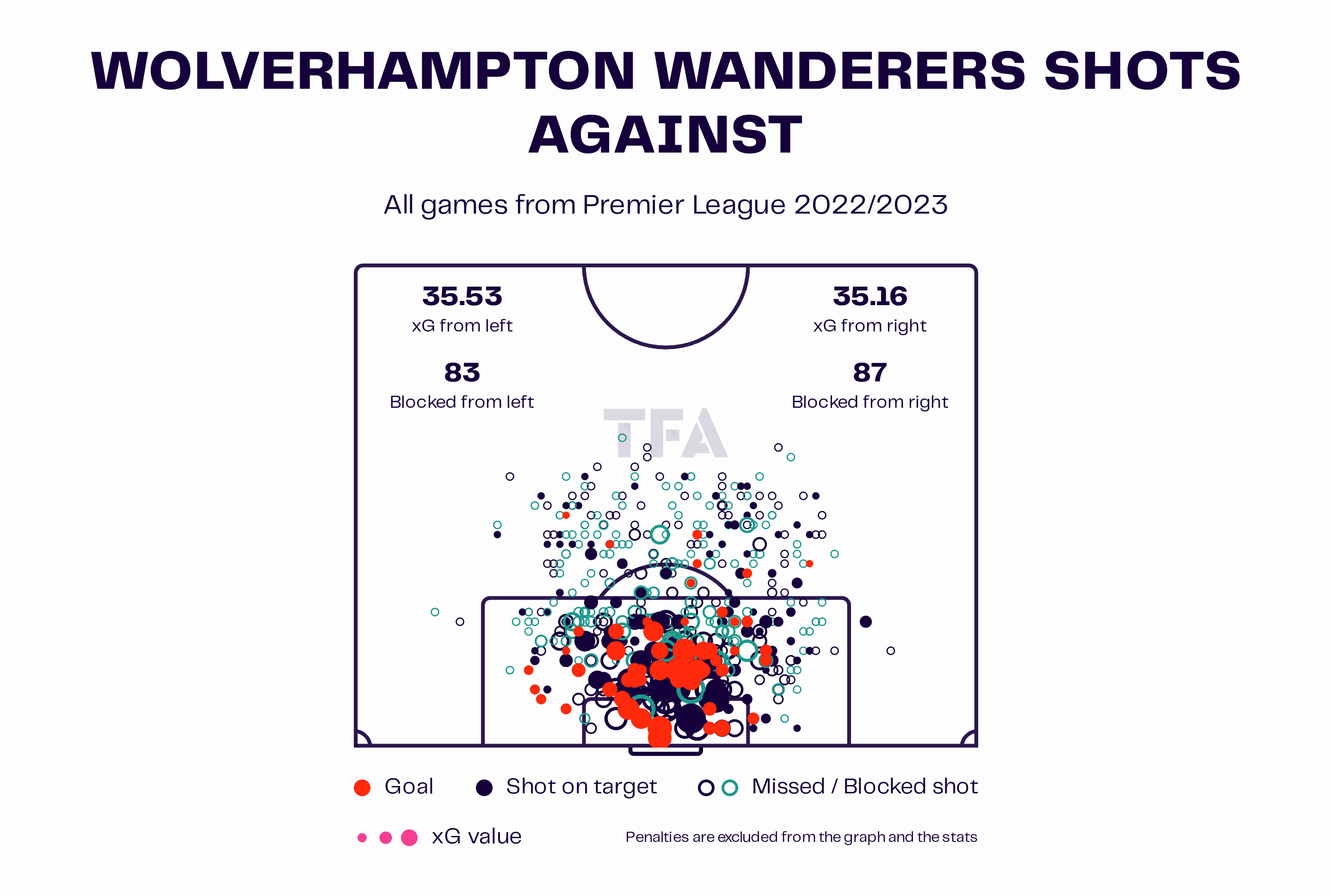
Wolves finished the season mid-table in 14th position for goals conceded. As with goals scored, Wolves’ statistics in this area improved after Lopetegui took charge. Two games, the 6-0 defeat by Brighton and a 5-0 drubbing by Arsenal on the season’s final day, skewed their goal difference massively. Without these anomalies, Wolves’ goal difference would have been much more respectable and made them the seventh–best defence in the league, level with Chelsea.
One concern for Lopetegui heading into the new season may be that 12 of their 58 goals conceded came from headers. This was the fourth-highest in the league. For perspective, Everton, who survived relegation on the final day and conceded a similar number of goals, only conceded from five headed shots all season.
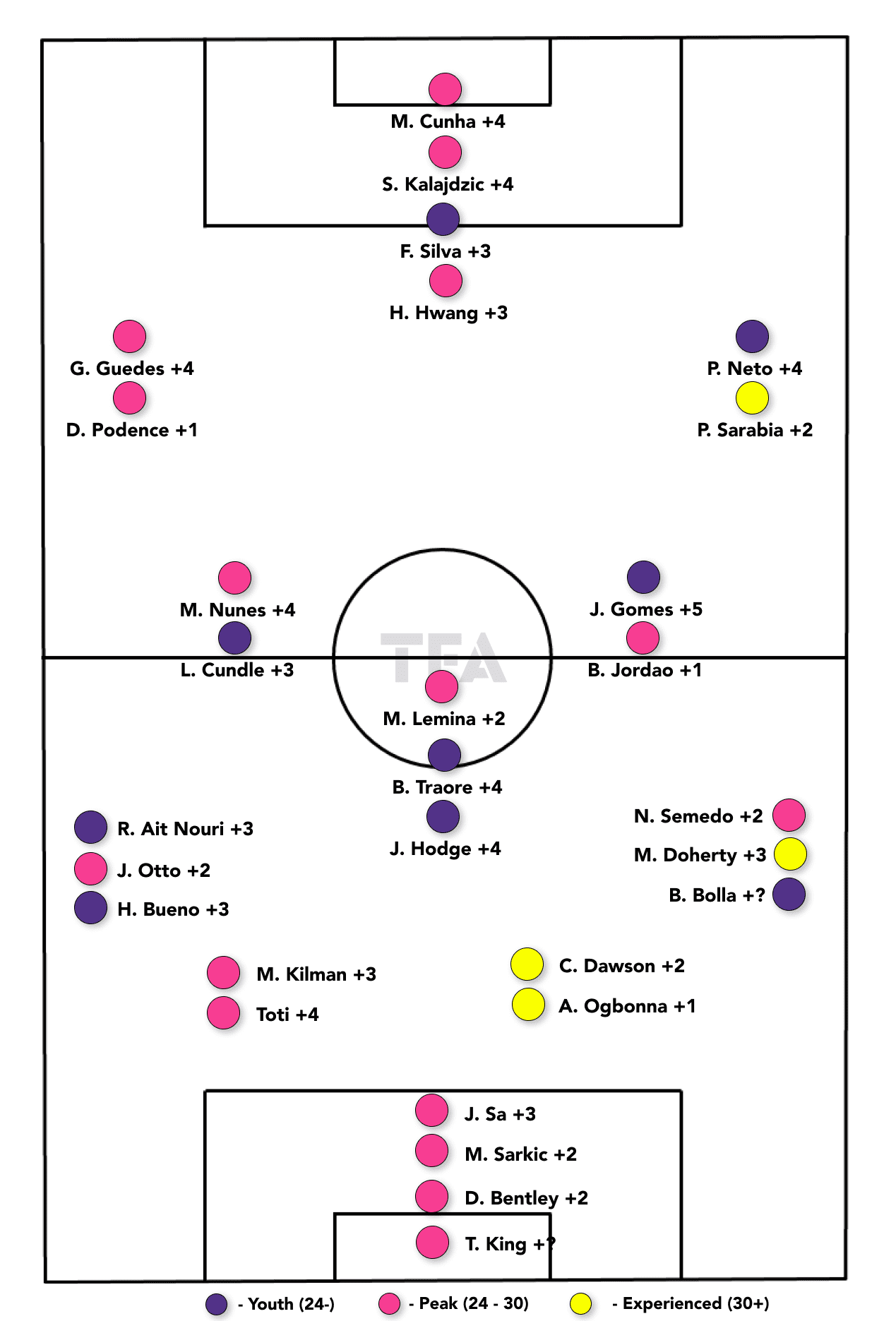
Wolves have lost several key players and long-serving talisman in this summer’s transfer window. Possibly the biggest to head for the exit is Rúben Neves. After six seasons at Molineux, the 26-year-old joined Al-Hilal in the Saudi Pro League. The Portuguese international played 35 times in the Premier League for Wolves last season, scoring six goals and assisting one.
João Moutinho is another long-serving player who has departed. Signed from Monaco in the summer of 2018, Moutinho has made over 200 appearances for the club. He did not feature in the season’s last three games, having played in 31 games before that. Besides missing the opening two fixtures due to injury, the Portuguese was involved in every match until matchday 33.
Adama Traoré, who played 34 games with two goals and two assists, also looks to be leaving the club. Wolves had reportedly tried to keep him, but he is set to leave the club with his contract having expired. Perhaps one of the more surprising departures is forward Raul Jimenez who has been allowed to join Fulham.
Although he scored just one goal in his time at Molineux, Diego Costa was a positive addition to the team featuring in 23 games. Costa was brought in to replace the injured Sasa Kalajdzic and provide a focal point upfront.
Two defenders have also departed. Republic of Ireland international Nathan Collins has joined premier league rivals Brentford. The centre-back featured in 26 league games last term. Connor Coady, who joined Everton on loan for the majority of last season, has also left the club by signing permanently for Leicester City.
Right-back Matt Doherty returns to the club on a free transfer, having moved to Tottenham in 2020. Doherty spent the second half of last season at Atletico but only played twice for the Madrid side. In his previous spell with Wolves, the 31-year-old made 260 appearances.
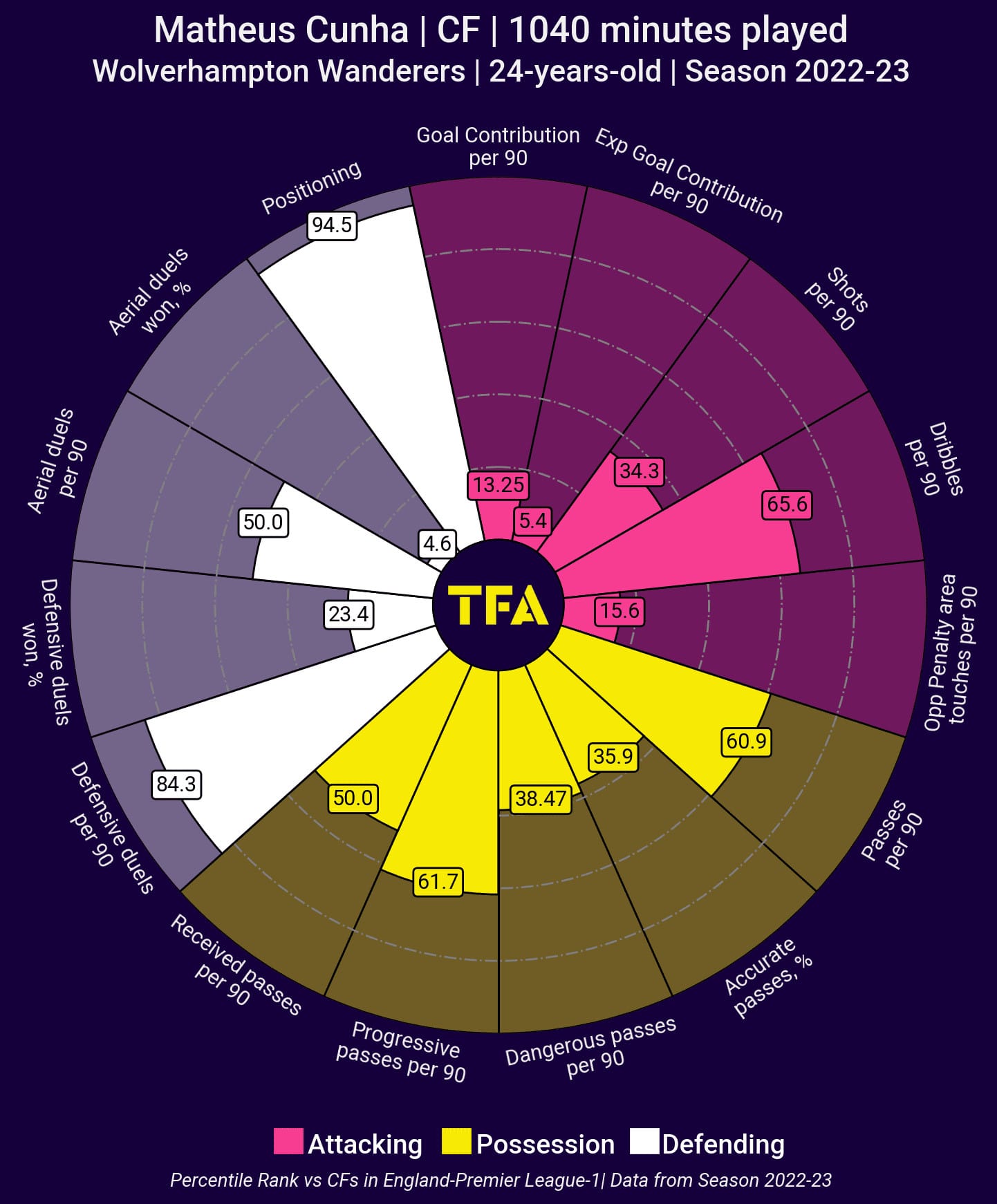
Matheus Cunha, who made 17 Premier League appearances last season whilst on loan from Atlético, has made his move permanent. Last season, the 24-year-old Brazilian netted just twice in the league for Wolves, while generating quite a low expected goal contribution tally as well. However, there are positives in his game that could appeal to the coaching staff, including his ball-carrying ability — which could be a useful weapon for his side — and his defensive work rate.
Wolves are expected to sign Aaron Creswell with the experienced left-back due to leave West Ham this summer. Other clubs are interested, but Wolves appear to be the frontrunners for his signature. The Liverpudlian made 28 Premier League appearances for the Hammers last season and came off the bench in their Europa Conference League Final victory over Fiorentina. Danish centre-back Victor Nelsson also looks like he is on his way to the midlands from Turkish side Galatasaray.
Attacking Phase
In the last 10 games of the season, Lopetegui flipped mainly between a 4-4-2 and 4-2-3-1. The one game they deployed a 4-3-3 in this period, historically the Spaniard’s preferred formation, came in the heavy defeat to Arsenal on the season’s final day.
Although not a “long ball” team in the traditional sense, Wolves placed third in the division for the most long balls with 42.22 per match. They were in 8th for accuracy, with 57.3% of their long balls reaching a teammate. However, this stat does not include the times when Wolves deliberately appeared to aim for the opposition’s centre-backs and play for the second ball. This tactic is just one of several variations of Wolves’ long ball.
Placing in the top half was a statistical success, but when the tactical element of deliberately playing for second balls is included, Wolves can be considered very efficient from long balls. As will be analysed in this section, nine of Wolves’ 20 previous goals in the league came, to some degree, from playing a long ball in the buildup.
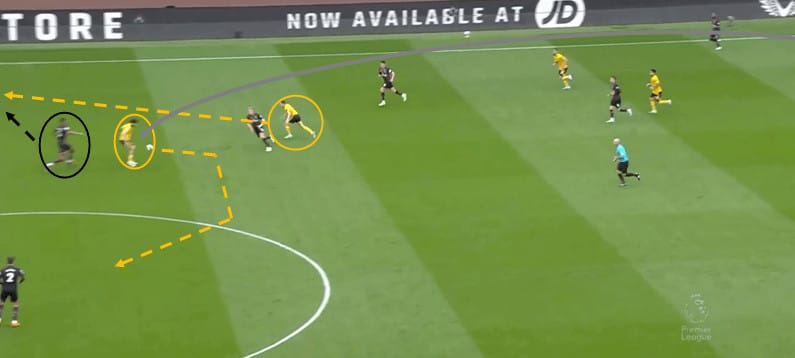
When the ball comes from deeper areas and is received in their own half, Wolves often play up to the striker facing his goal. In the image above, Costa, who was particularly good at doing this, has been tasked with holding the ball up. Here he is holding a long ball that has been played from the side of Wolves’ own box.
Wolves always have at least one player running beyond as soon as the ball is played. On this occasion, right-winger Pablo Sarabia makes a run down the outside of the centre-back. After initially engaging with him, the run distracts Costa’s marker enough that he drops off to cover the runner.
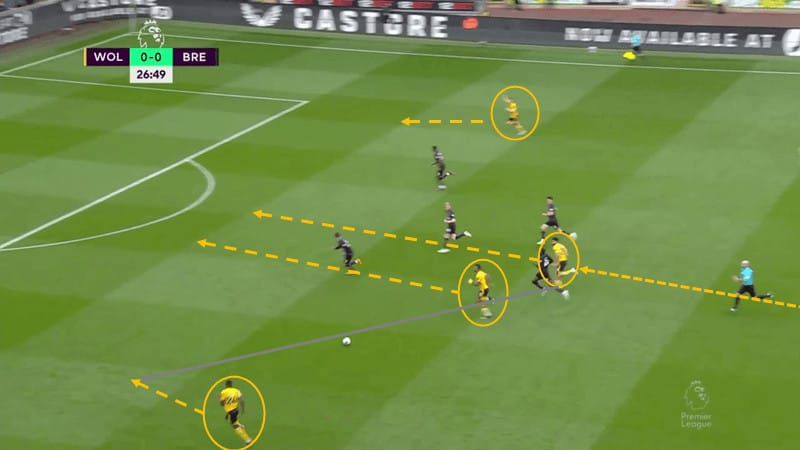
The centre-back dropping off allows enough room for Costa to turn on the ball and start dribbling at Brentford’s back line. Costa aggressively drives forward with the ball and is supported by Sarabia to his right and Toti and Mario Lemina to his left. Four players attacking the box is a common theme for Wolves regardless of the type of attack they are launching.
Here, the ball got played into the wide area for left-back Toti. Wolves’ full-backs arriving in the final third is another common theme to their play. Toti then provided a pinpoint cross for Costa, who finished inside the box. Crosses are another essential element of Wolves’ play, with two of their wingers, Neto and Traore, placing in the top 10 for the number of crosses per 90 in the Premier League.

In this example, in the build-up to Wolves’ first goal against Leeds, the long ball is hit in behind the opposition’s backline. Forward Sarabia’s starting position was high, up against a Leeds centre-back when his defensive midfielder got on the ball. Sarabia then moved off centre-back and onto the ball side of Leeds’ midfielders.
The angle at which he came towards the ball allowed him to control with his right foot whilst being able to see his forwards’ movements. Because of his high starting position, there was a delay in the midfield’s response to closing him down. This allowed him enough time to get his head up and clip a ball in behind for his forward to chase.
The forward’s starting position was a few yards in front of the defender when his teammate received the ball. This made the defender step towards the forward, preventing him from receiving the ball into his feet. Just as the defender stepped, the forward made his run in behind and was fed by Sarabia.

There are times when Wolves appear to deliberately play long to the opposition’s centre-backs before counter-pressing them and winning the second ball. Their second goal away to Southampton is an excellent example of this tactic in action.
Wolves’ deepest central midfielder intercepted a bouncing ball and delivered a looped volley, seemingly deliberately, onto the head of Southampton’s centre-back. The ball-near forward both threatened in-behind and applied pressure to the centre-back. This forced the defender to deal with the ball in the air. Because of the ball’s slow pace, the centre-back cannot get a reasonable distance on the header.
Wolves, having allowed Southampton to win the first ball, then pounced on the second. Again with four attackers, Wolves are very direct and immediately attack the goal, with João Gomes scoring from the edge of the box.
Another goal, in their 1-0 victory over Chelsea, came after central midfielder João Gomes, under little pressure, volleyed a clearance over his shoulder towards Chelsea’s centre-backs. The front two pressed the centre-back to force him to head clear whilst the central midfielders pushed up behind them. Wolves won the second ball and fed the ball to Daniel Providence. Providence then provided a great cross before Nunes’s breathtaking finish. Although what followed the long ball was an excellent play, the territory was gained by a straightforward long clearance and playing for the second ball.
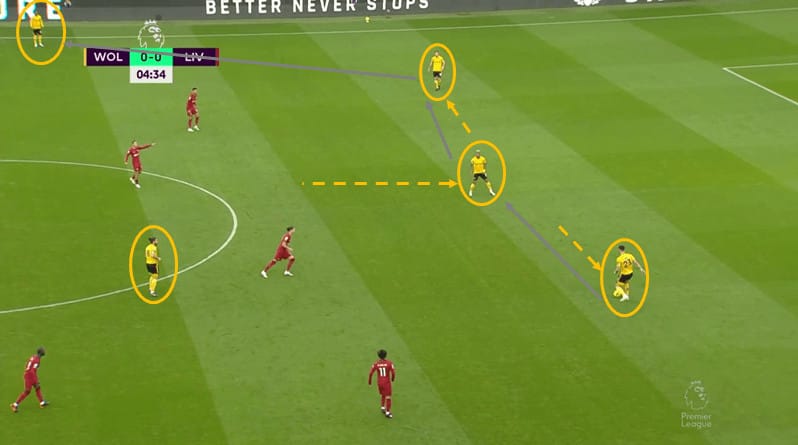
A typical phase of play in Wolves’ build-up is for one of the central midfielders to drop between the centre-backs. The centre-backs split, with the full-backs moving slightly higher. The wide-forwards then move inside the pitch.
In the above example from the build-up that leads to their opening goal Vs Liverpool, Lemina drops between the centre-backs. This makes it harder for Liverpool to press their back line and allows them to swing the ball from side to side more comfortably. In this example, as is typical, they moved the ball from right to left and back again before attacking down the side.
Although the wide-forwards are slightly inverted in this shape, Neves is heavily outnumbered in the middle. This is not a problem for Wolves, as the aim of their build-up does not appear to be to get Neves on the ball. Instead, they find a full-back and break down that side.
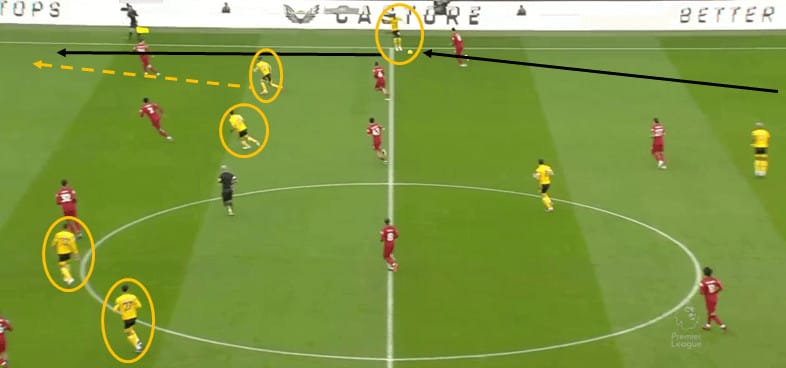
When they get the full-backs on the ball facing forward, the advantage of having the wide-forwards slightly inverted appears. Andy Robertson, Liverpool’s left-back, now cannot watch the ball and his man as he tries to backtrack and cover the space behind him.
The ball is played down the outside of Robertson whilst wide forward Sarabia runs on his blind side. The three other players in attacking positions attack the box. Wolves then work the ball into a crossing opportunity and deliver a cross which leads to the opening goal.
Defensive phase
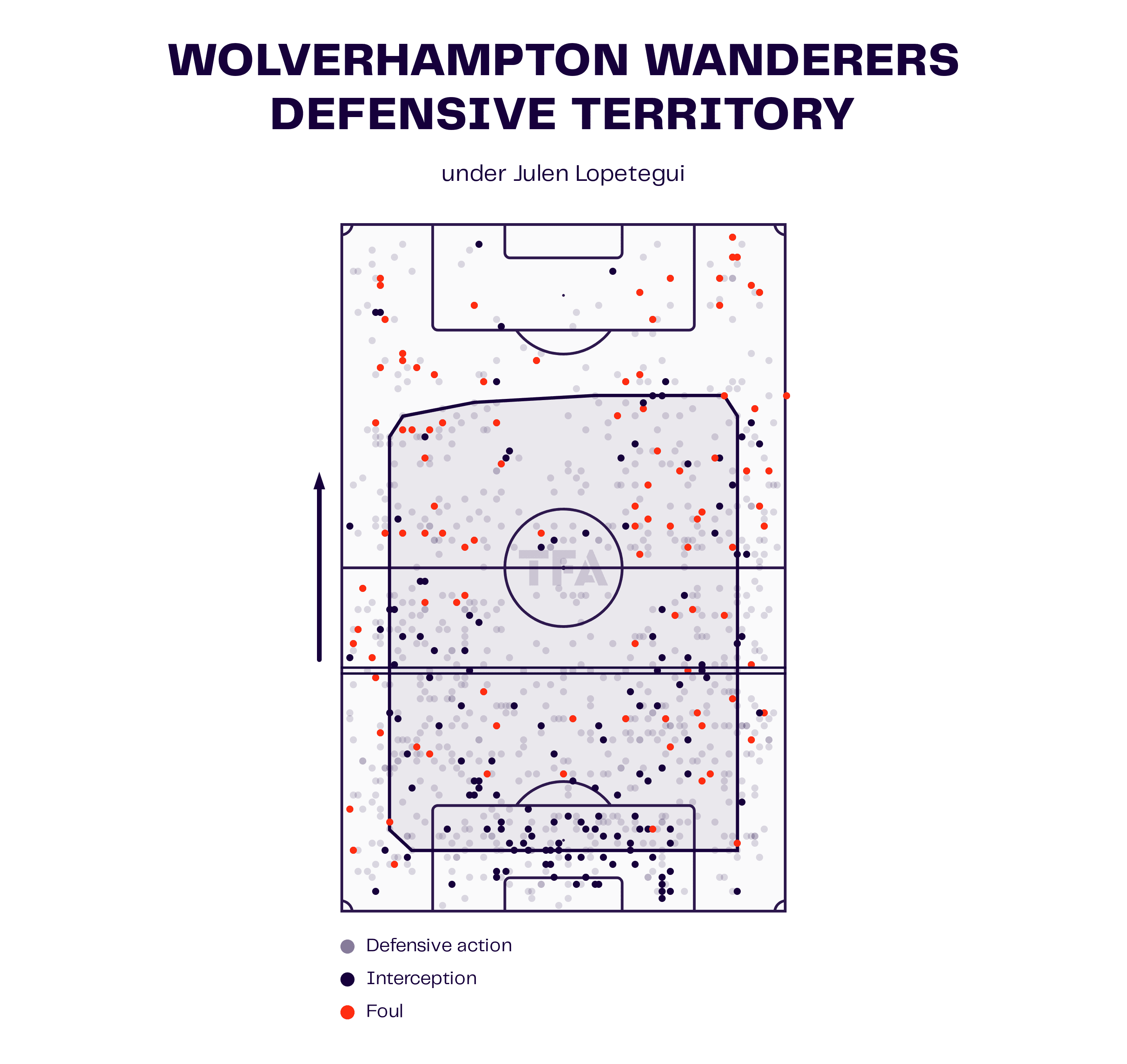
As the above data viz shows, Wolves under Lopetegui have typically dropped off into a mid-block. This is designed to draw the opposition out before isolating their defensive players and dispossessing them by forcing a loose pass.
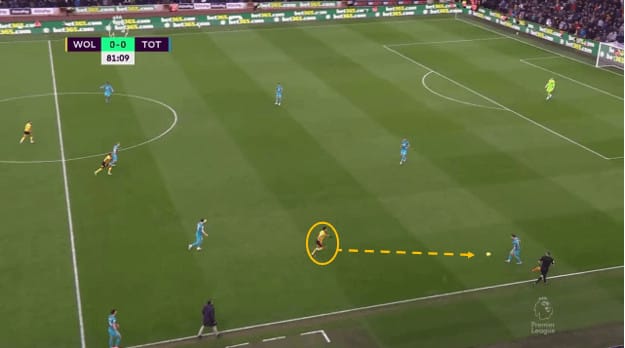
The above example shows Wolves having dropped into their mid-block before pressing high. Once the nearest player to the ball recognises a pressing trigger, on this occasion, a backwards pass, that player aggressively initiates the press. He is joined quickly by his teammates, who all jump and press the closest opposition players to the ball.
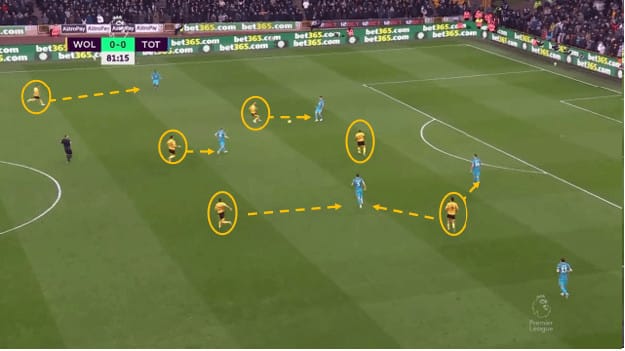
The first image shows that Wolves initiated the press with one isolated player going by himself. This image, seconds later, shows how quickly they stepped up and are now man for man on the edge of the opposition’s defensive third.
Traore, circled in the central area closest to the box, who was playing as the striker, splits the field in half. This prevents the ball from going back to where it came from and makes the direction of the next pass more predictable. All the players on that side of the pitch jump and get close to their mark. The speed at which they implement moving from a block to a press can often catch the opposition off guard.
This press resulted in a turnover of possession, and Wolves’ efficient transition to attack led to their winning goal against Tottenham. Although the shape they have played in has changed from game to game, the principles have remained throughout Lopetegui’s time.
Transitions phase
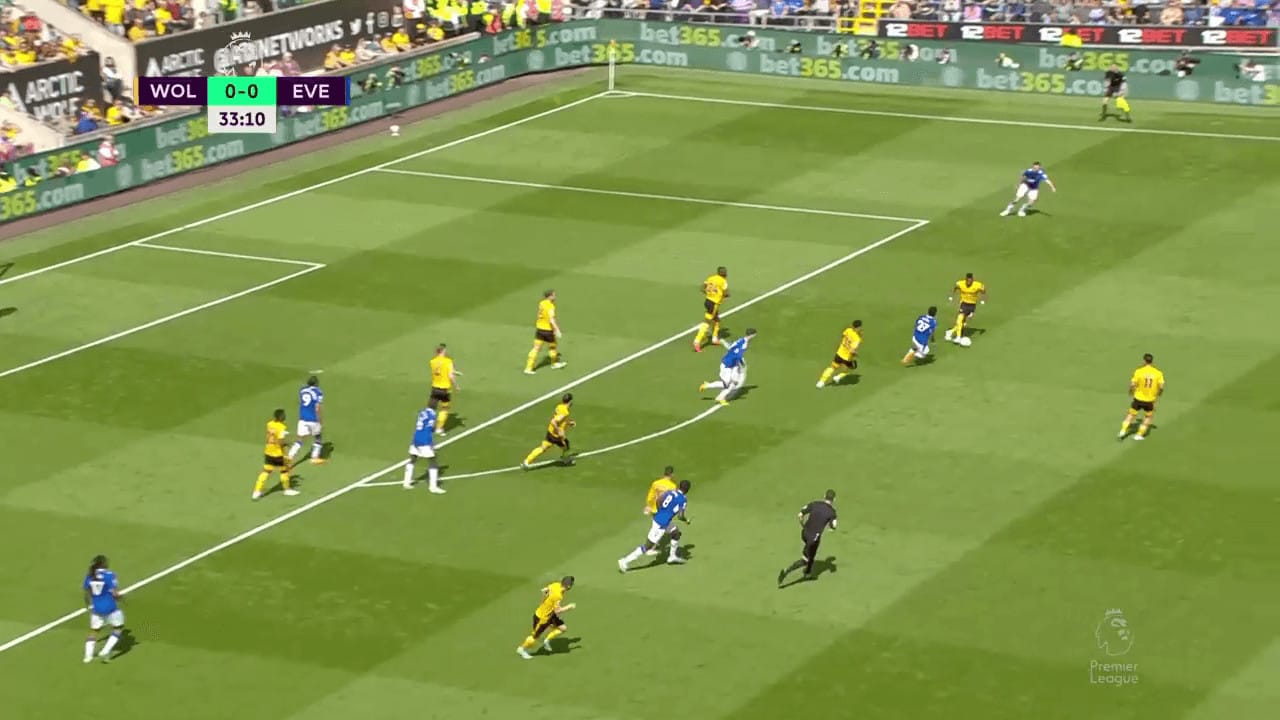
A large part of Wolves’ transitions, covered previously, is them counter-pressing or pressing from their block and quickly flooding forward. This section will provide an example of their quick attacking transitions from deeper areas.
A significant part of their counter-attacks came through the speed (and strength) of Adama Traore. The above image shows Traore intercepting the ball at the edge of his box. His immediate reaction is to dribble away from the counter-pressing Everton players.
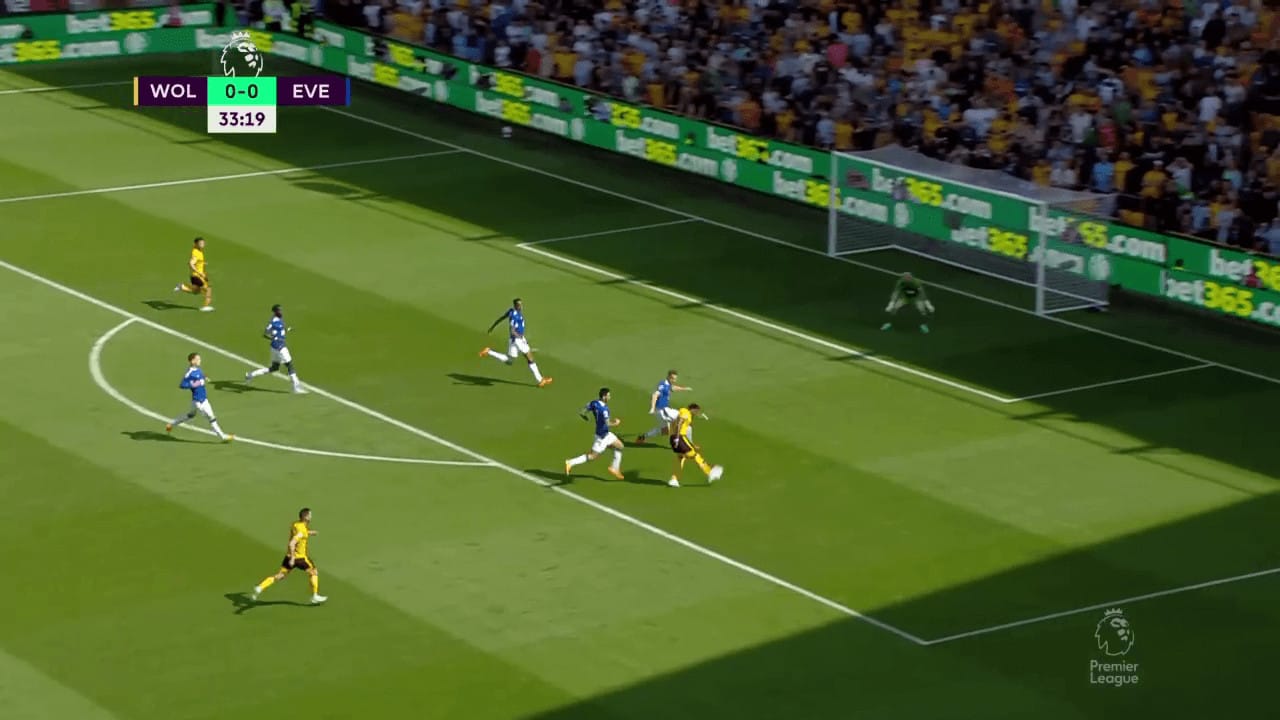
Traore carried the ball from one box to the other before unleashing a shot that the goalkeeper spilt. Hwang Hee-chan tapped in the rebound. If Traoe leaves as expected, he will take a major mode of Wolves’ attack over the previous five seasons.
How will losing Moutinho and Neves change their style of play?
Wolves’ playing style for next season, much like the direction of the club, is very uncertain at this time. Due to financial fair play regulations and the club’s financial situation on the whole, Wolves have so far failed to find replacements for key players.
The closest they have come to replacing the departed Moutinho and Neves is by bidding for Bristol City’s Alex Scott. The young midfielder has been impressive in the Championship and has attracted many suitors. Having at one point looked inevitable that he would join Wolves, this transfer is now in serious doubt. Other clubs, including Premier League rivals Bournemouth, have entered the race for Scotts’ signature which may end up pricing Wolves out of a potential deal.
However, there is still hope they will sign Scott and Wolves’ interest in him alone shows the direction Lopetegui may be trying to take his team. Scott is a very versatile player that can play in a variety of positions. He enjoys getting on the ball, more so than the current Wolves midfielders who are often missed out in the build-up. This may suggest that Lopetegui wants to transition to a more possession-bassed style of play. If Scott was deployed as a playmaking #6, this would allow Lopetegui to revert to his favoured formation of 4-3-3.
Key player: Matt Doherty
Although by no means the flashiest signing in the Premier League this transfer window, Doherty may have the most significant impact at Wolves. Doherty, who joins from Atletico, will not light the league on fire but will provide great consistency. He has also undoubtedly learned in Madrid from the defensive-minded Diego Simeone.
Wolves conceded 12 headed goals last season, the fourth–worst record in the league. Lopetegui’s side conceded numerous goals from crosses to the back post area, where their full-back was outjumped. Doherty’s 6ft2 frame could well fare better than the 5ft10 of Nélson Semedo.
The pizza chart above is from the last season Doherty played consistently and as a right-back (and not a wing-back). It shows Doherty was dominant in aerial duals. He was also among the best full-backs regarding the percentage of defensive duals won. This could be a significant difference from the full-backs Wolves have deployed this season, who are possibly more known for their attacking prowess than defending.
This signing may also help reduce the number of set-play goals Wolves have conceded. Although Wolves finished mid-season in this regard, the number conceded doubled between the 2021-22 and 2022-23 seasons. Doherty is also good at progressing the ball out of the back. With a coach that enjoys attacking down the sides of the pitch, this will fit in well with Lopetegui’s system.
One to watch: Sasa Kalajdžić
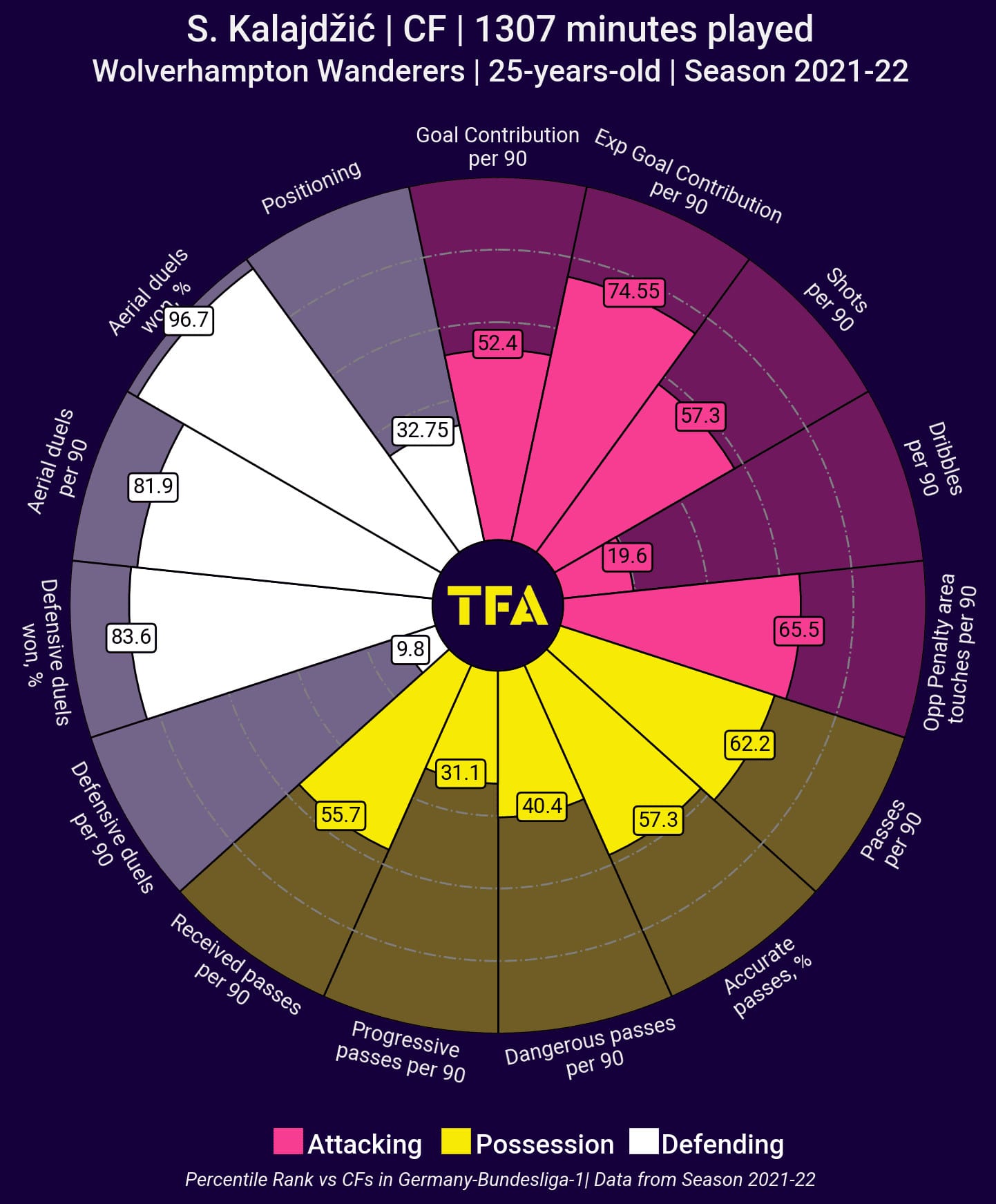
Having torn his ACL 45 minutes into his Wolves debut against Southampton in September last year, Saša Kalajdžić almost feels like a new signing for Wolves. The Austrian international has completed pre-season with the team and looks set to be available come the first game.
We’ve looked at his 2021/22 season for our pizza chart above, with a lack of sufficient data available for him over the last couple of seasons. As the image displays, the attacker is dominant in the air and capable of contributing a lot to the team’s goalscoring efforts.
The 6ft7 central striker scored 21 goals in 51 Bundesliga matches for Stuttgart and also found the net regularly whilst playing in the Austrian Bundesliga. With forwards Costa and Traoré having left, along with top scorer Neves, a lot will be resting on Kalajdžić having a successful season. Wolves fans will hope Kalajdžić can regain the form that got him a move to the Premier League.
TFA Verdict: 15th
There is no doubt this is a weaker Wolves squad than before in their recent Premier League history.
But, in Julen Lopetegui they have a manager that should be able to extract as much as is possible from the players – and that could mean a 15th-place finish. That said, Lopetegui is certainly a coach who could end up not completing the season as a poor start could see the transfer wounds reopen.





Comments